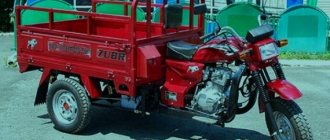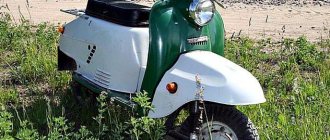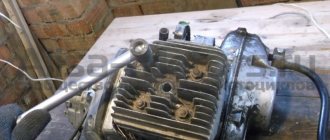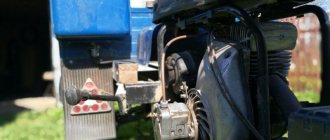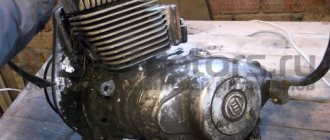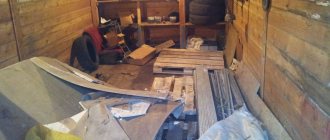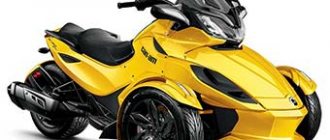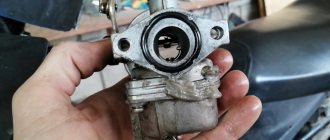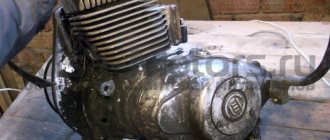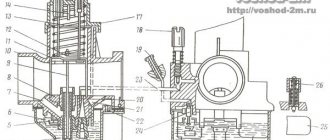The Ant scooter was produced at the Tula Machine-Building Plant from 1959 to 1995. Its modification, or as they say now, restyling, was carried out in 1983 and the updated version received the designation Ant 2M 01. The longevity of this unusual three-wheeled vehicle was brought, first of all, by positive qualities, among which it is necessary to highlight:
- versatility;
- affordable price;
- simple repair;
- compactness;
- maneuverability.
The TMZ Ant scooter was the first cargo model of motorcycle equipment mass-produced in the USSR. The presence of a cargo platform allowing it to transport 250 kg of cargo at a speed of 60 km/h made the Ant very popular. It is enough to note the areas in which it was used:
- Transportation within the city, including small batches of products for restaurants, cafes and canteens.
- In-plant transportation, when small batches of certain components were moved between production departments.
- Transportation of small volumes of building materials, especially in urban environments.
- Carrying out transportation inside enclosed spaces, primarily for agricultural purposes (greenhouses, poultry farms, livestock farms).
For various modifications of the TMZ Ant scooter, four body options were used:
- open;
- open reduced (installed on the cargo-passenger version);
- awning;
- van.
The most significant drawback is the lack of any comfort for the driver, who was forced to spend almost the entire working day behind the wheel of a scooter. It was especially difficult to work in winter, since, unlike two-wheeled mopeds, scooters and motorcycles, the Ant cargo scooter was used at state-owned enterprises even in winter.
Motor scooter Ant: adjusting the clutch with your own hands
Like any other equipment, the “Ant” scooter can break down and need repair. But thanks to its structure, repairs can be done independently.
The “Ant” clutch is one of the weak points of the scooter, which needs frequent adjustment and cable replacement.
Carefully observe the clutch, as problems can be divided into 2 main causes:
- The clutch drives. In this case, problems are possible:
- the cable has become unraveled, rusted or bent;
- adjusting nuts are too tight;
- large free play of the lever;
- crooked discs.
- The clutch is slipping. Possible reasons:
- The cable has become unraveled, rusted or bent;
- The adjusting nuts need additional tightening;
- There is no free play of the lever;
- Crooked discs.
In any case, if there are problems with the clutch, you need to check the condition of the cable :
- If upon visual inspection it is not bent or damaged, then it is worth lubricating it with oil. To do this, you will need a mixture of gasoline and oil, diluted one to one. Using a syringe, pour this mixture into the casing.
- If the cable is bent or damaged, then there is only one way out - replace it with a new one.
If necessary, we proceed to check and adjust the clutch nuts.
Instructions for adjusting the clutch nuts:
- Unscrew the locknut of the adjusting screw;
- Using a screwdriver, slightly unscrew the adjusting screw;
- We twist it back until you feel that it has rested against something;
- We tighten the locknut;
- We look for the clutch lever on the steering wheel - press it, at the same time watch the pressure plate. It should not come off lopsided. If it comes off, then use a screwdriver to adjust the corresponding nuts until the disk moves perpendicular to exactly the axis of the basket
- On the engine, we look for the clutch lever free play adjustment bolt - tighten it so that the free play is 5-10mm.
Device and technical parameters
The design of the Ant scooter was quite simple and consisted of the following main parts:
- engine;
- frame;
- transmission and suspension;
- electrical equipment;
- brake system;
- body.
Such a simple design of the Ant 2M 01 scooter and its wide unification with the two-wheeled Tulitsa (Tula) model allowed the owners to carry out repairs themselves.
The TMZ Ant motor scooter had the following technical characteristics and operational parameters (data for modification of the Ant 2M motor scooter are given in parentheses):
- Drive – 3x2.
- Load capacity – 0.25 t (0.28 t).
- Engine: type – petrol two-stroke,
- ignition – electronic;
- number of cylinders – 1,
- volume – 0.20 l,
- cooling option – forced air,
- power – 11.0 l. With. (12.5 hp),
- carburetor - K-36G,
- fuel – a mixture of gasoline and oil (1/33).
- base – 1.78 m,
- type – mechanical,
- weight – 0.24 t,
Pros and cons of the Ant scooter
Despite very modest technical advantages, the device has a couple more trump cards.
- The engine is turned on using a starter, just like in cars. All thanks to the built-in kick and dyno starters;
- It is lighter than a motorcycle equipped with a sidecar and more spacious;
- Very maneuverable. The turning radius is only 3.5 meters, which allows you to maneuver in narrow rural streets or in old areas of cities;
- Nice price. It varies from 30 to 40 thousand rubles; The price-quality ratio for the Ant scooter is very decent;
- Easy to repair. Even a beginner can figure out the structure of this Soviet scooter without watching training videos, and you can get to all the parts by simply turning the unit on its side. Such accessibility allows repairs to be carried out anywhere and at any time, which, you see, is irreplaceable.
But, of course, cargo scooters also have additional disadvantages:
- Frequent breakdowns. Despite the Soviet assembly “for centuries”, not every foreign tricycle can withstand 25 years of service. The situation is further complicated by the fact that new parts are no longer available in Russia, and in China the spare parts are not of the highest quality.
- Poor cross-country ability on sticky soil. Due to its impressive weight, even without cargo, the Ant may simply not get out of the sand or mud on country roads. There is no point in talking about uncleared snow at all.
- Impossibility of tuning. No one does cosmetic repairs to such equipment; at most, they change the main unit when the original one cannot be repaired. But if you really want to, you can take on the tuning of the “Ant” scooter yourself.
Despite its shortcomings, such a cargo scooter is an excellent helper at a summer cottage or in a rural area, and if you choose the Ant motorcycle, you won’t go wrong.
Peculiarities
The Ant cargo scooter is quite easy to maintain. If it breaks, you can turn it on its side and make repairs or replace parts. However, it cannot be called economical, since a 2-liter single-cylinder engine consumes as much as 8 liters per 100 kilometers , and after wear of the piston system it is 10 liters. However, at that time the cost of gasoline was low, so there were no problems with operation.
The simplicity of the motorcycle’s structure does not require any special knowledge of a mechanic, because even to remove the tire there is no need to re-mount it. Simply unscrew the bolts located in a circle. These types of features of the moped allow repairs to be made anywhere, without special equipment. Which is very convenient, because it’s no secret how often Soviet equipment breaks down. However, in case of serious engine and chassis breakdowns, which occur quite often, the knowledge of a mechanic is sometimes simply necessary.
If necessary, you could choose a moped with the most suitable configuration. Thus, models with an additional seat for a passenger and models with a closed body were released.
The Ant scooter currently has many analogues in Asian countries. Road congestion in Asia has made the cargo moped one of the most popular models for hard workers. It allows you to easily navigate narrow alleys and significantly reduces travel time. The Chinese analogue and the original Ant scooter, although they do not have significant differences in appearance, are strikingly different in quality.
Maintenance and repair
Due to its low weight, this moped, if necessary, can be “put on its side” even alone. Also, given that Ant disc wheels consist of 2 halves bolted together, replacing a damaged tire is quite simple. To connect the tube and the spare tire, it is necessary to separate the parts of the removed wheel.
Motor scooter repair Ant
Tools
In order to properly repair a Soviet moped, you will need the following tools:
- double-sided wrenches (set), 4-22 millimeters;
- screwdrivers - 3 pcs. (large, medium, small);
- hammers, 2 pcs. (100 and 300 grams);
- combination forceps;
- wooden stick;
- wire cutters;
- pliers;
- socket wrenches (4 pcs.);
- velvet files - 2 pcs. (flat).
Reincarnation of the classic Ant scooter - now with an electric motor
Recently, the automotive world has been trying to abandon the usual type of internal combustion engines as much as possible in favor of electric motors. And following passenger cars, light truck manufacturers are switching to batteries, attracting the attention of lower prices, fewer man-hours for maintenance and the absence of the usual engine noise. Thus, I bring you to today’s review of the Rutrike Dukat 1500 1000W electric cargo tricycle.
A little about the Rutrike company. Since 2010, the RuTrike team has been developing, designing, manufacturing and selling electric vehicles. Since 2021, RuTrike has launched a separate direction - commercial electric transport, and since 2021, the assembly line of RuTrike electric three-wheelers has been deployed in Russia. The entire RuTrike line meets Russian quality standards. That is, everything that you see below meets Russian standards.
The electric tricycle was delivered by a transport company in a semi-assembled form, covered with MDF sheets. I don’t have any photos of the delivery kit, but who cares: the front wheel, fender liners, and sides are located separately from the tricycle.
After unloading, we carry out basic assembly of all components. The final view of the electric tricycle or “Ant”, as is common among the common people, is as follows:
Characteristics:
- Color: blue
- Warranty: 12 months
- Voltage: 60V
- Brand: RUTRIKE
- Battery type: Traction GEL
- Battery charging time: 8-10 hours
- Operation: all-season
- Dimensions: (mm) L x W x H 2900 x 1110 x 1355
- Speed: up to 25 km/h
- Mileage: up to 80km
- Battery capacity: 32Ah not included
- Motor power: 1000W
- Front brake: hydraulic disc
- Dry Weight: 230kg
- Load capacity: 750kg
- Rear brake: drum
- Low gear: Yes
- Front wheel: 3.50-R12
- Rear wheel: 4.00-R12
- Front suspension: Hydraulic shock absorbers
- Rear suspension: Springs
- Cargo compartment size: (mm) L x W x H 1500 x 1000 x 450
- Additional passenger seat: yes
- Country of origin: Russia
With its dimensions of 290 * 111 * 135.5 cm, the Dukat 1500 is a compact model and allows you to operate the tricycle in narrow streets and courtyards.
The appearance has not undergone any fundamental changes in comparison with the Soviet three-wheeled cargo scooter Ant. An important difference is the absence of a gasoline engine under the seat.
The Rutrike Dukat 1500 electric tricycle, unlike its prototype, is equipped with a hydraulic fork rather than a lever-type front suspension. Therefore, only time will tell whether this is the right decision.
The front brake system is hydraulic, the Chinese JWL acts as a caliper. Front tire size - R12*3.50.
The light block is located in its usual place, just below the double horn and reflector. The light source is a lens with an LED; there are low and high beam modes. The light itself is bluish and shines in a beam in the center, so you can’t really count on good light.
Instead of an analogue speedometer, there is now a digital instrument cluster with display. If you pay attention to the upper left corner, you can see a version of the tricycle with a gearbox (Gear unit), but my version is without a gearbox. In the center, large numbers are responsible for the current speed; smaller numbers indicate the battery charge and battery voltage. Below the dash there is an ignition switch with a standard 3 positions.
The maximum speed is limited to 25 km/h. During normal operation, our cruising speed is about 10-12 km/h, while there is no particular bumpiness on the road and there is better stability during maneuvers.
Standard controls:
- on the right - gas, switching the direction of movement (forward/backward), toggle switch for the HML speed mode (High, Medium, Low). When reverse gear is engaged, the corresponding lamp in the tail section lights up and a loud, methodical squeak begins to be emitted.
- on the left - light switch, power supply to the electric motor, turn on turn signals, horn
The side mirrors are not particularly informative, no matter how hard I try to adjust them. It’s easier to turn the body half a turn and appreciate the scale with your own eyes.
To service the hydraulic brakes, there is a small reservoir located behind the right throttle grip. During maintenance, it is recommended to fill in DOT3 or DOT4 brake fluid. There are no regulations on the number of engine hours.
The driver's seat is quite wide and can accommodate two men of standard build. In this case, the brake pedal is located under the right foot, thereby creating inconvenience for the passenger sitting next to it. The brake pedal is cable-operated and is responsible for the rear drum axle, while behind the gas handle is the front disc brake handle.
Under the right hand at the bottom of the seat there are 2 levers: the upper one is responsible for downshifting, the lower one acts as a handbrake. Downshifting occurs in the rear beam gearbox. Quite a convenient option if you need to slow down to overcome obstacles.
Anyone familiar with the design of the classic Ant should remember that the driver's seat is located directly on the engine. There is an electric tricycle here, which means the space under the driver’s rear should be empty. But what was my surprise when under the seat there was space for 3 large watermelons, among which was a small charge controller.
However, the electronics in the Dukat 1500 are made surprisingly clumsily, and on the other hand, they are elementary: an IEC 60320 connector for connecting a standard charger, a protective single-pole Chinese circuit breaker for 63A and a charge controller of a similar production.
Since the space under the seat is quite spacious, the manufacturer quickly figured out where to hide the complete charger. Its parameters are input AC220V (380W), output DC60V (360W). The full charging time is 8-10 hours (according to the passport), but we charge the tricycle overnight. Therefore, it is difficult to name a more precise time.
We close the lid, which doubles as a seat, and move to the back of the tricycle. By the way, the seat is made of leather. It is also difficult to judge its quality and durability.
Like the classic Ant, the Dukat 1500 is a cargo vehicle. Therefore, the body has 3 folding sides: two side and one front. A 3mm thick corrugated iron sheet is provided as a body platform. The dimensions of the cargo compartment are 1500*1000*450mm. This tricycle is used for transporting linen, small and large household appliances, thanks to its spacious body and absolute silence in operation.
The maximum load capacity is 750kg. We have not tested such weights, but we have already transported 300 kilograms several times and, with a low gear engaged, drove up a small hill without any problems.
If there are not enough folding sides, you can always lift the entire body. This is done simply and by one person. The lifting mechanism is nameless gas struts.
The most interesting thing lies under the body, namely traction gel batteries manufactured by RuTrike. An assembly of 5 60V batteries provides a range of up to 80 km on a single charge. We don’t know the actual mileage yet, since in 8 hours of a working day we only manage to roll out 1/3 of it and put the tricycle on charge.
As for the batteries themselves, they are not included in the kit of the tricycle. On the manufacturer’s website there are several assembly options for different mileage, so the final choice is tailored to the customer’s requests. Below is a discharge graph of one 6-EVF-55 gel battery.
The electric motor is a new generation 1000 Watt brushless traction motor, which does not have factory markings or any parameters. Only RuTrike engineers know what kind of motor this is.
The electric motor shaft is connected to the gearbox in the rear axle, and the cable from the lowering lever also fits there.
To control the electric motor, a BMS controller is provided, which is installed in close proximity to the electric motor. The controller is connected to the battery assembly and the motor in a black box located nearby. And it would be better if I didn’t open it and see the chaos that’s going on there..
Now briefly about the rear suspension, and here everything is quite banal, since it is represented by ordinary springs. When the body is empty, the rear end tends to jump when driving, but if the body is loaded, the problem goes away. Like its prototype, the Dukat 1500 likes to roll during sharp turns.
The rear wheel differs slightly from the front and has parameters R12*4.00. The wheel is pneumatic, all-season tread.
One of the interesting points in the tricycle that I did not note earlier is the ability to adjust the parking brake. With the basic setting, the brake pedal is weak and not particularly informative.
There is also additional space in the body, made in the form of a driver’s backrest, which can recline into the body and take the form of a bench. This feature allows you to transport 2 adults in the back while sitting on it.
In work, a cargo tricycle always helps out; if previously you had to drive an old UAZ Bukhanka around the territory, now you can move it near residential buildings and not be afraid to interfere with the loud roar of the engine. The size of the cargo compartment is sufficient for transporting large-sized cargo, for example, external air conditioning units from chiller-fan coil units fit perfectly into the body along with two loaders.
Therefore, moving away from conventional gasoline engines to electric ones on the scale of hotels, resorts, and even workshops is a completely rational decision. Especially if you translate fuel costs and compare them with the energy spent when charging a tricycle.
As for the Rutrike Dukat 1500 electric tricycle itself, it is generally well made, but it’s hard to give a solid “A” for the implementation and fitting of all the parts.
What is the model
The Ant motorcycle is distinguished by a reliable metal trike, made in the form of a platform with a tailgate . Moreover, such a trailer is large enough so that many different items can fit into it. The vehicle is widely used to transport:
- seedlings;
- building materials;
- fertilizers;
- beehives, etc.
On the other hand, the Ant moto is quite maneuverable and unpretentious. The turning radius of the bike reaches 3.5 m. The vehicle does not take up much space in the garage.
In the winter season, the Ant moped should be filled with a mixture of motor oil and 76 gasoline. In the summer he drives on M8B fuel.
A few words about the trailer
You can also make a trike yourself. The spaciousness of the body is indicated by the photo of the Ant scooter. A standard trailer consists of:
- stroller frame;
- L-shaped steel bracket;
- two clamps;
- tubular struts.
It will also be interesting: Izh Planet Sport - an exclusive motorcycle from the USSR
When working on the trike, it is very important to ensure that the trailer shell does not come into contact with the bracket. To increase the rigidity of the body, a steel gusset can be welded. In addition, it is important to make a homemade trike with an opening and removable tailgate. The sides and bottom are covered with boards. Additionally, the trailer is equipped with lighting equipment (dimensions, brake lights, turn signals).
A short summary
So, the Ant moped is a real Soviet classic . At the time of release, this vehicle was one of the best options in terms of price/quality. And now such a bike demonstrates good technical parameters. But, since the motorcycle has not been modernized for a long time, its fuel consumption is very high.
Thus, maintaining such a workhorse will cost a lot of money, so the bike is more suitable for lovers of rare models than for people who are looking for transport for daily use.
Video review of the Ant scooter:
Engine characteristics
In fact, the engine itself is not bad: moderately reliable, simple, maintainable and not whimsical. If it were not for its extremely unreliable and capricious dyno starter, which, according to the good old collective farm tradition, is usually abolished and a magneto is installed
- Type - two-stroke, single-cylinder with three-channel purge
- Cooling - air, forced by fan
- Cylinder diameter - 62 mm
- Piston stroke - 66 mm
- Working volume - 199 cm
- Compression rate - 7.6 kg/cm
- Power - 13 l. s./9.6 kW at 5200 rpm
- Carburetor - K62G
The biggest advantage of the Ant over other two-stroke Soviet consumptives was its spacious and very comfortable body and the presence of reverse gear.
